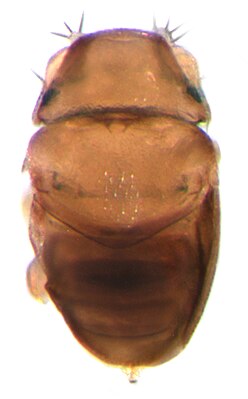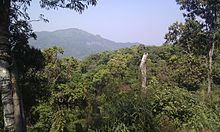Euryplatea nanaknihali
| Euryplatea nanaknihali | ||||||||||||
|---|---|---|---|---|---|---|---|---|---|---|---|---|

Euryplatea nanaknihali , female in dorsal view |
||||||||||||
| Systematics | ||||||||||||
|
||||||||||||
| Scientific name | ||||||||||||
| Euryplatea nanaknihali | ||||||||||||
| Brown , 2012 |
Euryplatea nanaknihali is a fly art from the family of the humpbacked flies (Phoridae). The animals are about 0.4 mm long and are therefore the smallest known two-winged birds . Their way of life has not been explored, but they are probably parasitoids on ants like the related Euryplatea eidmanni . Euryplatea nanaknihali is characterized by a compact, rounded body, short wings and small eyes. The known distribution is limited to Thailand , where the species was found in 2008 in the Kaeng Krachan National Park . It wasdescribedby Brian V. Brown in 2012.
features
Euryplatea nanaknihali is about 0.4 mm long and has a limuloide body shape, that is, head and abdomen are compact and rounded similarly as the plate of horseshoe crabs . The body of the species is sparsely covered with bristles and of a light brown color. The eyes of the fly are very small in relation to the rest of the body. The species lacks ocelli and forehead bristles. Under the antennae it has two times four cheek bristles. The first flagellomer is long and pointed, the antennae bristles are short and long feathered. The palpus corresponds to the basic construction plan of the humpback flies and is covered with long, thick bristles. The mouthparts are well developed with large, broad labella. The pronotum has no long bristles, a scutellum does not have this type. The legs are short and only sparsely covered with long, robust bristles. The posterior femur is enlarged and very broad. The back tibia has a row of dense, palisade-like arranged bristles. The tarsomeres are short and rounded in E. nanaknihali , their 0.23 mm long wings are greyish in color. The Costa loader is extremely long with 0.9 times the wing length. The radial cores are largely fused. The wing veins R 2 + 3 are missing from the species as well as thin veins. The holders reach about a third of the wing length. The abdominal tergites are completely present, the abdominal sternite is absent. E. nanaknihali has a pointed, for parasitoids typical ovipositor .
distribution

Euryplatea nanaknihali is so far only known from Thailand , where it was discovered in the Kaeng Krachan National Park . In view of the distribution of the genus Euryplatea , this is remarkable, as the only other known species, E. eidmanni , occurs only on Bioko off the Atlantic coast of Equatorial Guinea .
Way of life

Most likely, Euryplatea nanaknihali , like many other humpback flies , parasitizes ants by laying eggs in their heads, which are later dropped off by the larvae's enzyme production. Since the closest related species, E. eidmanni , only attacks Crematogaster impressa , it is likely that E. nanaknihali also parasitizes species of the genus Crematogaster . However, there are no representatives of this genus in Thailand that could be considered in terms of size or geography. Only in nearby Vietnam is C. rogenhoferi a species that, at 2 mm, would be small enough to serve as a host for the fly.
Systematics
Besides E. eidmanni, Euryplatea nanaknihali is the only representative of the genus Euryplatea . The holotype, a female imago , was discovered in 2008 and first described by Brian V. Brown in 2012 . With the epithet honored Brown Nanak Nihal Weiss, "a young entomology enthusiasts from Los Angeles ", hoping to fire up the enthusiasm continues.
swell
literature
- Brian V. Brown: Small Size No Protection for Acrobat Ants: World's Smallest Fly Is a Parasitic Phorid (Diptera: Phoridae). In: Annals of the Entomological Society of America 105 (4), 2012. doi : 10.1603 / an12011 , pp. 550-554.